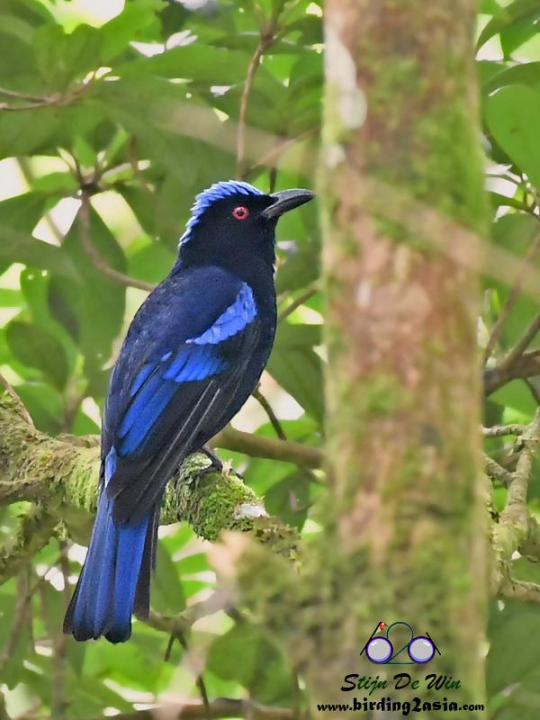
Asian Fairy-Bluebird by Greg Hume, CC BY-SA 4.0
Etymology: For the Goddess of Peace and Plenty
First Described By: Jerdon, 1863
Classification: Dinosauromorpha, Dinosauriformes, Dracohors, Dinosauria, Saurischia, Eusaurischia, Theropoda, Neotheropoda, Averostra, Tetanurae, Orionides, Avetheropoda, Coelurosauria, Tyrannoraptora, Maniraptoromorpha, Maniraptoriformes, Maniraptora, Pennaraptora, Paraves, Eumaniraptora, Averaptora, Avialae, Euavialae, Avebrevicauda, Pygostaylia, Ornithothoraces, Euornithes, Ornithuromorpha, Ornithurae, Neornithes, Neognathae, Neoaves, Inopinaves, Telluraves, Australaves, Eufalconimorphae, Psittacopasserae, Passeriformes, Eupasseres, Passeri, Euoscines, Passerides, Core Passerides Passerida, Irenidae
Referred Species: I. puella (Asian Fairy-Bluebird), I. cyanogaster (Philippine Fairy-Bluebird)
Status: Extant, Near Threatened – Least Concern
Time and Place: Since 10,000 years ago, in the Holocene of the Quaternary


Fairy-Bluebirds are known from Southeast Asia, India, Indonesia, and the Philippines

Physical Description: Fairy-Bluebirds are medium sized passerines, ranging between 21 and 27 centimeters in length. They are distinctive birds – with short tails, round bodies, and large sharp beaks, their coloration and patterning makes them iconic and beautiful birds. The males have dark blue bodies with light blue tail feathers, and stripes of black and lighter blue on the wings; they have light blue patches on the tops of their heads, and black heads in general, with red eyes. The Philippine species has noticeable stripes on the wings, while the Asian species is more blocky in color. Female Philippine birds resemble the males, except duller; the females of the Asian species, however, are turquoise all over, with black patches on the tails. The two species mainly differ from each other in how the blue and black on the wings and bodies pattern with each other. The juveniles tend to be like the females, except brown instead of black.

Philippine Fairy-Bluebird by Stijn De Win
Diet: Fairy-Bluebirds feed mainly on fruit, including small berries and figs, as well as nectar and some termites.
Behavior: Fairy-Bluebirds will wander around branches, searching for fruit while perched or in quick flights in the middle of the canopy. They’ll generally join mixed-species flocks to forage, all gathering food together in large groups – especially if a lot of food is present. They make very whistling and fluid calls to each other when finding each other, often with a variety of different trilling and chirping syllables. The males make a variety of songs as well, including ones with oddly scale-like syllables as well as more titillating vocals. Mated pairs will also make harsh, croaking sounds to one another. The Philippine Fairy-Bluebird also will imitate contact calls of other species. These birds do not migrate much, though they may move in response to water availability.

Asian Fairy-BLuebird by Gran Hume, CC BY-SA 4.0
In terms of nesting, the birds breed mainly in the first half of the Gregorian Year, and the male has a very elaborate courtship display – including vocalizations that are responded to by the female doing most of the nest building. They build a small, shallow cup of twigs, placed a few meters up in a tree. Two or three eggs are laid and incubated by the mother for two weeks. Both parents will help care for the brood another two weeks. The Philippine Fairy-Bluebird begins nest building a little later, more of the middle of the year.
Ecosystem: Fairy-Bluebirds mainly live in tropical to subtropical rainforest and evergreen forest, as well as montane forests. They tend to avoid more deciduous forests, though they can be found in such locations in response to flowering events. They may also be found in low-growth forests. They tend to be victims of brood parasitism by Cuckoos.

Asian Fairy-Bluebird by Ano001, CC BY-SA 4.0
Other: Fairy-Bluebirds are not considered threatened with extinction at this time. The Philippine Species, though common in its range, has declined in population due to extensive habitat loss. As such, it is classified as near-threatened. The Asian Species is common in most of its range, though some populations are more uncommon and, due to habitat loss, populations are on the decline. It is also caught for the cagebird trade, greatly affecting populations.
Species Differences: The Asian Fairy-Bluebird is found across Southeastern Asia, on the coasts of India, and in some parts of Indonesia. The Philippine Fairy-Bluebird, meanwhile, is only known in the Philippines, as its name would suggest. The Philippine species is also somewhat larger. In the Asian species, females are blue all over, while the Philippine females resemble the males except they are duller in color.
~ By Meig Dickson
Sources Under the Cut
